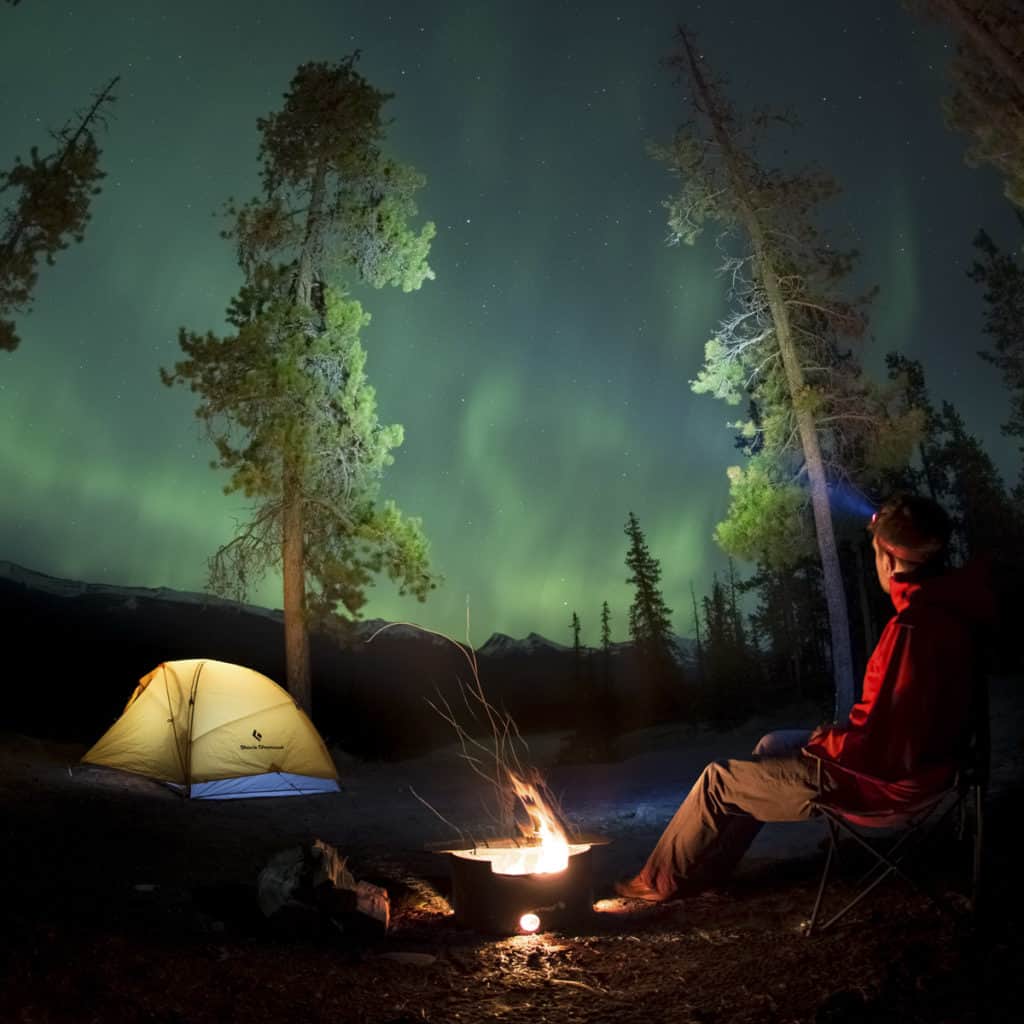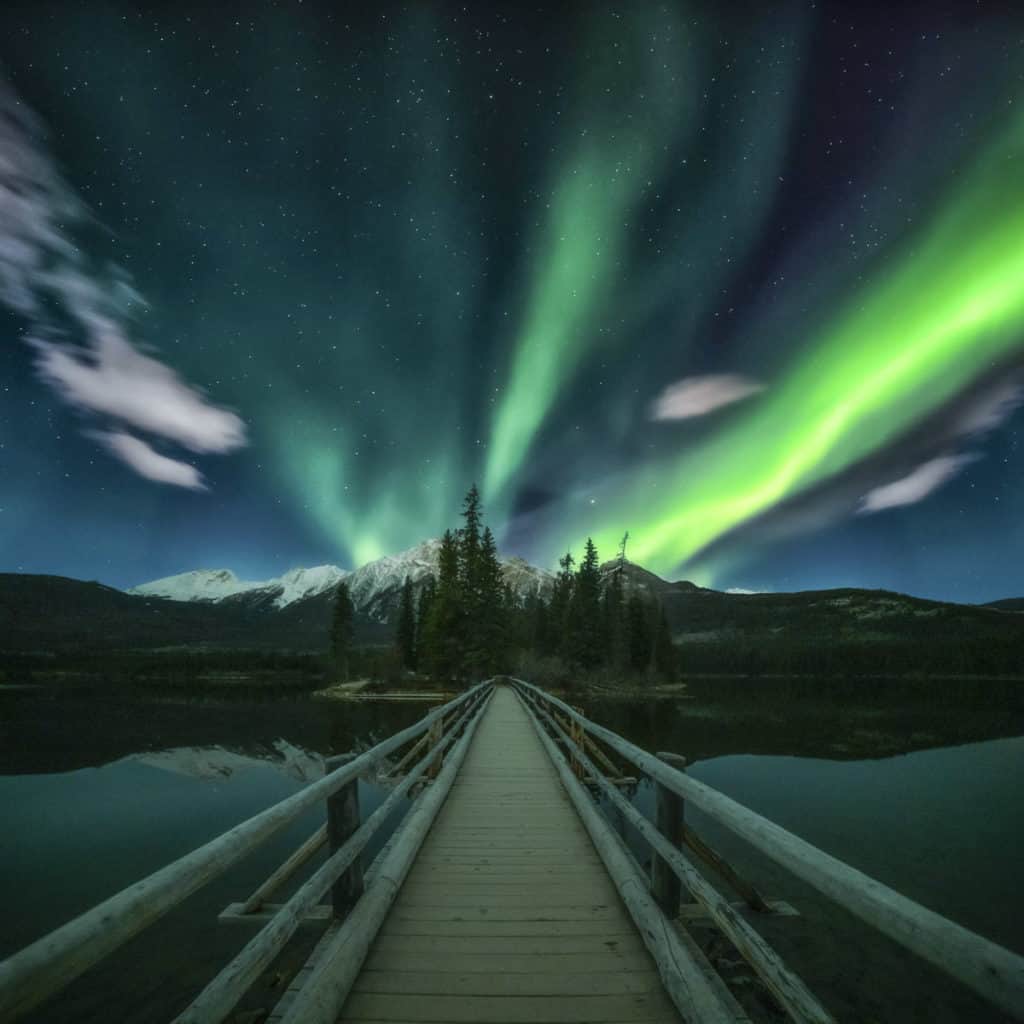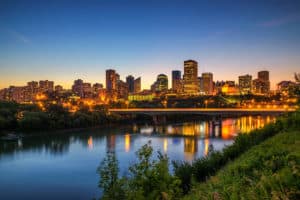Disclaimer: This page may contain affiliate links. Please review our full Terms and Conditions for more information and our Privacy Policy. Note that any pricing, operating hours, or other such information provided below may have changed since initial publication.
Compiled by the Road Trip Alberta team / Written by Dalene Heck
Last updated on January 8, 2025
Growing up in far northern Alberta, I would see the bright green lights dance across dark night skies countless times. I saw them so often that I thought they were actually pretty unremarkable! It never occurred to me that they are a unique natural phenomenon that causes some people to travel from afar to see them. In fact, Canada is one of the spots in the world to see the Northern Lights. Spots like Yellowknife, Northwest Territories, Churchill, Manitoba and Labrador all bare witness to the Aurora. But we think Alberta is one of the best places to witness this phenomenon.

Now I realize that seeing the northern lights in Alberta is a pretty special experience. And this is why I am eager to share these tips on how to best enjoy them.
About Northern Lights or Aurora Borealis
Also known as aurora borealis, the northern lights are created when energized particles from the sun meet the earth’s atmosphere—or rather, they violently slam into it! The earth’s magnetic field then redirects them toward the north pole, creating the lights that streak across the sky, dazzling anyone who sees them.
The first suspected record of northern lights is a cave painting from 30,000 BC. They have since been integrated into many legends, folklore, and teachings. For the Cree, a significant Indigenous nation in northern Alberta, the translation from their language means the spirits are dancing. Without a doubt, they have long fascinated humans.
Best Time to See Northern Lights in Alberta
The tricky thing about seeing northern lights in Alberta (or anywhere on Earth) is that they can truly be hit or miss. No matter how badly you want to, there is no guarantee that you will see them. Even if there are enough energetic electrons to light up the sky, clouds can also ruin a viewing. The key is to be patient, plan your trip in the right season, follow alerts and weather forecasts, and hope for the best.

Northern lights can be visible all year round, but most likely in the colder, darker months from September to mid-May (which is why aurora borealis spotting is one of the best winter in Alberta activities). Geomagnetic activity is highest during autumn and spring equinoxes, making September, October, and March the peak months.
When you’re in the province, there are two great, frequently updated options for finding out if the conditions are favourable to see them:
- My Aurora Forecast. Download the Aurora app to see the likelihood of viewing the aurora borealis no matter where you are, considering the activity and cloud coverage. You can also set alerts to notify you when the lights are most active in your area. If you’re game for a 2 am wake-up call to hustle you outside to see them, this app will notify you.
- Aurorawatch. The University of Alberta (based in Edmonton) set up a website to track northern lights activity in the area, and some other parts of Alberta. It’s not the most well-constructed website, but the information is up-to-date and helpful.

Where to See Northern Lights in Alberta
If you want the best chance, you guessed it… head north! (And out of town, as you want to the sky to be as dark and light-pollution-free as possible.)
While every region of the province will likely get at least one opportunity to view the lights in a year, the farther north you go, the better your chances are. And the more brilliant they will be! That said, there is also something pretty magical about seeing them dance around mountains, so even though the Rockies don’t extend very far north, we’ve included some central and southern Alberta options as well.
Northern Lights in Fort McMurray
This most populous city in northern Alberta is one of the best places to head to spot the lights. They are said to be possibly visible 300 nights of the year (if the conditions are right). Rumour has it that glass igloos are on the way, too, which means you can sleep under the lights as they dance. (Although, who’s really going to be sleeping?)
There are a number of great places in Fort McMurray to view them, including:
- Raphael Cree Boat Launch is in the city’s Waterways neighbourhood and thus is a good place to view them without having to venture too far.
- Parsons Creek Park is near Coventry Drive, on the Parsons access road.
- OHV Staging Area (Tower Road) is popular and only 2 km from Tower Road.
- Wood Buffalo National Park is a bit of a journey, but as the world’s largest dark sky preserve, will provide the absolute optimal viewing spot. If you’re equipped for winter camping, then this will be a truly unforgettable experience.

In addition, there are local operators offering tours:
- Birch Mountain Outfitters is a brand new Indigenous-led experience that runs two weekly tours for three nights. Get set up in a heated trapper’s cabin or teepee in a well-equipped camp to spot the lights during the night. By day, enjoy dog-sledding or ice-fishing.
- Beyond Adventures offers a wilderness experience. You will be based in an outfitter’s tent until 2 a.m., enjoying the silence, stars, and lights. Snowshoes, tea, coffee, and snacks are provided.
County of Northern Lights
It’s in the name! Starting just north of the town of Peace River, this county crosses the same latitude as Fort McMurray but is on the western side of the province. A little more difficult to get to (there are few and expensive flights to Peace River from Edmonton), a trip to this county promises a more off-the-beaten-path experience.
Dark Sky Preserves
Alberta has many wide-open spaces, and many regions have smartly protected their skies with a special commitment to preserving the night by minimizing light pollution in all its forms. Visiting any of these places will ensure that your Aurora borealis viewing will be optimal.
Jasper National Park
Jasper is your best bet if you want to be in the mountains enjoying the northern lights. Regardless of aurora spotting, this is our favourite spot in Alberta for outdoor adventures (and many other great things to do in Jasper, including the Dark Sky Festival they hold every October). Popular spots include Maligne Lake, Pyramid Island, and the Jasper Planetarium at the Jasper Park Lodge.

Elk Island National Park – Beaver Hills
East of Edmonton, the Beaver Hills Dark Sky Preserve includes Elk Island National Park, and the Cooking Lake Blackfoot Provincial Recreation Area. This is where the Royal Astronomical Society of Edmonton often meets. If the forecast is good, there are plenty of spots to see the northern lights in Elk Island National Park.
Wood Buffalo National Park
This large swatch of land is almost as north as north can go—it is north of Fort McMurray. Catching the northern lights in Wood Buffalo National Park should be easy if the weather is good, as it is one of the world’s largest dark sky preserves. It’s not easy to get to, but the effort is definitely worth it.

Cypress Hills Interprovincial Park
Encompassing a parcel of land in southeastern Alberta and southwestern Saskatchewan, the gently rolling hills of Cypress Hills Interprovincial Park can provide a pretty backdrop for night sky viewing and photos of the aurora borealis.
Waterton Lakes National Park
Added in 2021, this beauty of a park and Glacier National Park in the USA became the first International Dark Sky Parks spanning both sides of an international border. Because Waterton Lakes National Park is up against Alberta’s southern border, there is a diminishing opportunity to see the northern lights, but the night skies are stunning nonetheless. Operators have recently opened in the area to offer interpretive stargazing tours.

Lakeland Provincial Park
The newest provincial park to be added as a dark sky preserve is Lakeland Provincial Park, which is north of Edmonton and east of Lac La Biche. They even hold a Dark Sky Celebration each year on the third weekend of September.
Where to See the Northern Lights in the Canadian Rockies!
There are plenty of spots to see the northern lights in Banff National Park and Jasper National Park. To get that perfect backdrop, we suggest heading to Pyramid Lake (Jasper), Abraham Lake (David Thompson Country), and Peyto Lake or Lake Minnewanka (Banff). These spots are beautiful day or night, without any light pollution, offering excellent backdrops for viewing and photos.

Anywhere in Alberta!
As we have previously mentioned, if the forecast is strong for Aurora and the weather forecast is clear, then your chances of seeing the northern lights will be very good. There’s even a chance you’ll see them as far south as Lethbridge and Writing-on-Stone Provincial Park. The key is finding a spot that is void of light pollution so that you can see them clearly in the sky.
There are a lot of open spaces with perfectly dark skies that will allow you to view and photograph northern lights with minimal light disruption. Use this dark sky finder to find the nearest spot. It is fairly intuitive – the black spots are those that are darkest – but note that it does not take current weather (cloudy skies) into account. Nor does it consider localized lights (i.e. a bright security light on a remote farmhouse) that could impede viewing.
From the hoodoos in Drumheller to the prairies and mountains, Alberta is one of the best spots for the northern lights in Canada.

Tips to Photograph the Northern Lights
Seeing the aurora borealis is a magical experience! But do you know what’s even better? When you can capture those special moments with a camera and relive them for years to come.
Photographers travel from around the world to capture the northern lights in Alberta and you don’t need to be a pro to get a good shot of the green lights dancing. There are certainly some key photography tips to employ to capture the perfect shot:
- As we’ve said above, a dark night with a clear sky is paramount. Use the apps and websites above to find a good place to plant your tripod.
- While the phones’ cameras are getting much better with every release, it is possible to get good Aurora shots using their dark mode setting. Ideally, using a DSLR camera is still better. In either case, having a tripod is also important. Your camera must be perfectly still to avoid any blur in your photos.
- Using a wide-angle lens is ideal.
- You need a camera that has more than “auto” mode, as being able to control various settings is essential.
- Start with these manual settings: Turn your aperture as low as possible (f4, or f2.8 if you can) to let in as much light as possible. Adjust your ISO to start at 3200-6400. Turn the white balance to “daylight”, and shutter speed to a 5-15 second exposure. Take a couple of shots that way, and then adjust if necessary. If the aurora is very bright and active, then you’ll want to reduce your ISO and/or shutter speed.

- To add some dimension, focus your camera on the closest interesting element. Perhaps a person standing in front, or maybe a fence post or a tree. If that is not available or you want to get the sky on its own, then focus on the brightest star or planet in the sky.
- It helps to have a cable release for your camera in order to press the shutter remotely. Remember that any movement to your camera can cause blur, so try and keep your fingers off of it. Another option is to set your camera to a “timer mode” to reduce any vibration from hitting the shutter.
- As the optimal aurora viewing times are in the colder months, dress warmly! Bring a thermos filled with something warm to drink, and be prepared to spend time waiting. Photographing the northern lights in Alberta can require a lot of patience.
Additional Resources
- Edmonton’s Chapter of the Royal Astronomical Society of Alberta has published “dark sky etiquette” to ensure that anyone who is out enjoying the lights is respectful of others who are as well.
- There is a very active “Alberta Aurora Chasers” Facebook group that lives up to its name. If you want to chase the northern lights in Alberta – get in there!
If you’re out chasing northern lights in Alberta during the darkness of night, you’re going to want a good hotel to rest your head in after! Here’s our advice on where to stay in the tourist hot spots:

Dalene Heck is a co-founder of Road Trip Alberta. She was born in Edmonton, grew up in the Peace Country, and has ventured to almost every corner of Alberta and the world (she’s travelled to 60 countries)! She is a serial blogger, the CEO of HMI Marketing, co-creator of the Trip Chaser card game, a leukemia-slayer, and cat whisperer.







